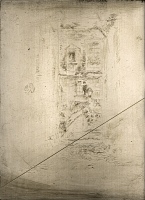A French Street | ||
| Number: | 405 | |
| Date: | 1888 | |
| Medium: | etching and drypoint | |
| Size: | 135 x 98 mm | |
| Signed: | butterfly at left | |
| Inscribed: | no | |
| Set/Publication: | no | |
| No. of States: | 1 | |
| Known impressions: | 1 | |
| Catalogues: | K.-; M.-; T.-; W.- | |
| Impressions taken from this plate (1) | ||
KEYWORD
dog, lamp, street.
TITLE
Whistler's original title is not known, so descriptive titles were given to the copper plate:
'Unpublished Plate, possibly French' (1903/1935, possibly Rosalind Birnie Philip (1873-1958)). 1
'A French Street' (2003, Hunterian Art Gallery). 2
The plate came from Whistler's estate and was given by Miss Birnie Philip to the University of Glasgow in an envelope labelled 'Unpublished Plate, possibly French'. The Hunterian Art Gallery revised this to the more acceptable descriptive title, 'A French Street'.
'Unpublished Plate, possibly French' (1903/1935, possibly Rosalind Birnie Philip (1873-1958)). 1
'A French Street' (2003, Hunterian Art Gallery). 2
The plate came from Whistler's estate and was given by Miss Birnie Philip to the University of Glasgow in an envelope labelled 'Unpublished Plate, possibly French'. The Hunterian Art Gallery revised this to the more acceptable descriptive title, 'A French Street'.
1: Envelope containing copper plate, Hunterian Art Gallery.
2: Museum records.
DESCRIPTION
A view down a narrow cobbled street to a cross street, with a gas-lamp jutting out from the corner on the right, and a dog standing at the corner on the left. At the far side of the street is a steep-roofed three-storey building. There are many-paned windows, one with a small balcony, and the two upper windows have peaked eves.
There are three rows of shading in a lopsided semi-circle that appear to conflict with the doorway at the bottom of this building. This may have been an attempt to indicate light falling from the street lamp, or it might be the remains of an earlier drawing.
SITE
It could be a street in Bourges, Tours or Loches.
DISCUSSION
It is not known why this was not printed, or, if printed, why no impression has been located. It may be that Whistler simply produced too many etching plates during 1888 and was unable to process them all, or it may have been among works destroyed after his wife's death.

